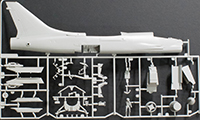
Monogram 1/48 F-8 Crusader Kit First Look
By Michael Benolkin
| Date of Review | May 2017 | Manufacturer | Monogram |
|---|---|---|---|
| Subject | F-8 Crusader | Scale | 1/48 |
| Kit Number | 5826 | Primary Media | Styrene |
| Pros | Nice kit of the F-8E | Cons | See text |
| Skill Level | Basic | MSRP (USD) | Out of Production |
First Look
 |
 |
 |
 |
The late 1940s/early 1950s brought together a number of developments that would transform military aviation. First and foremost was the first successful transition through Mach 1 in level flight by Captain 'Chuck' Yeager in 1947. The engineering data flowed out to aircraft designers and that, in turn, led to the first operational supersonic aircraft, the F-100 Super Sabre for the US Air Force followed soon by the F8U Crusader for the US Navy. Another development that enabled these two aircraft was the Pratt and Whitney J57 afterburning turbojet engine. The afterburner on the J57 was a simple on-off power setting, not the variable thrust 'zones' of the modern afterburner.
The Vought design team developed the F8U design to meet the Navy's requirements but it required further innovation to operate safely from aircraft carrier decks. The high-wing design necessitated the need for short and sturdy landing gear in the fuselage, and with the engine, fuel, avionics, etc., all housed in that fuselage, the result was a long, low-slung aircraft. Carrier approach speeds would require nose-high attitudes which would impair the pilot's view of the ship on approach and the tail section would strike the deck on touch-down (crash). Vought's solution to this was a variable incidence wing, a wing that would raise seven degrees which allowed for the slow-flight attitude on approach while keeping the fuselage relatively level at touch-down.
Both the F-100 and the F8U ran into drag problems at transonic speeds which led to the discovery of 'area rule' in future aircraft. The lack of area rule would be one of the limiting factors of the F-100 (along with the absence of an intercept radar). While the F8U was a slab-sided aircraft like the F-100, the designers had integrated a hump on the fuselage over the wing to house Bullpup missile avionics and in flight test, that hump provided the Crusader with area rule (of sorts) and the aircraft would ultimately reach Mach 1.8+ while the similarly powered F-100 would not exceed Mach 1.3.
The F8U-2NE (F-8E) was the last production version with 286 examples built. The F-8E provided a newer radar, improved J57 engine, Martin Baker ejection seat, and an IR search/track sensor ahead of the windscreen. The F-8 would become known as the Last of the Gunfighters because another technology had also appeared in the early 1950s - the guided missile. The F-8 was designed as a gun fighter with secondary armament of rocket packs (early Crusaders) or Sidewinder missiles (later versions). The F-4 that followed didn't have gun armament internally until the F-4E and while subsequent fighters do have the M61 Vulcan or similar guns, they are a close-in last resort once the missiles are gone or no longer effective.
In the late 1980s, the best kit of the F-8 Crusader was this new-tool (then) 1/48 scale kit from Monogram. As with other kits in the series, the F-8 is an easy build yet offers a wealth of details. The kit was designed in the era of raised surface panel lines, yet these are not overdone speed bumps as found on other kits of the day. Since that time however, Hasegawa has tooled the best kit of the Crusader in 1/48 while Trumpeter has produced the best F-8s in any scale (less than 1:1). So while there are more modern options available, this kit is not ready to be tossed away. Among the features and options in the kit:
- Nicely detailed cockpit
- Optional pilot figure
- Positionable canopy
- Positionable wing folds
- Positionable stabilators
- Nicely detailed wheel wells
- Positionable air refueling probe
The kit offers the following external stores:
- Dual AIM-9 rails with 4 x AIM-9 Sidewinders
- Six Mk.117 bombs on underwing TERs
The decal sheet provides two decal options:
- F-8E, 149202, VF-11, AB/211, USS Roosevelt
- F-8E, 150328, VMF(AW)-235, DB/8
The kit doesn't provide an option to raise the variable incidence wing though there are a few aftermarket sets that will provide the fuselage plug under the wing as well as the lift mechanism. While the Hasegawa kits provide the positionable wing, they don't provide the weapons stores options.
This is one kit that has been in and out of my collection over the decades and since I found this one at a recent IPMS show, the price is such that you could almost use the fuselage Y pylons and underwing pylons to enhance the Hasegawa kit at a price less than many such aftermarket sets. If you don't care about having the wing lifted in take-off or landing configuration (where you'll also need to position the flaps as well), this kit is a quick build to serve as a subject for one of the many colorful aftermarket decal sets produced for the Crusader.







